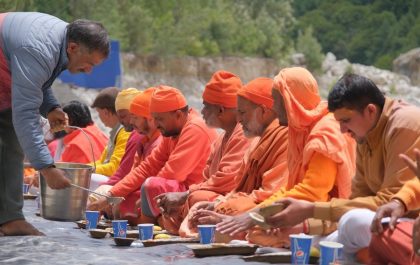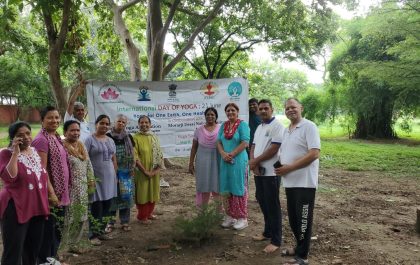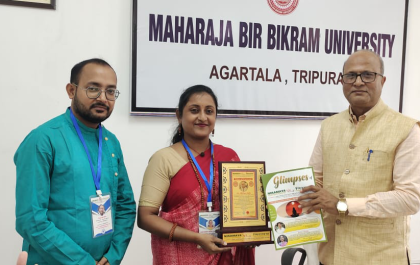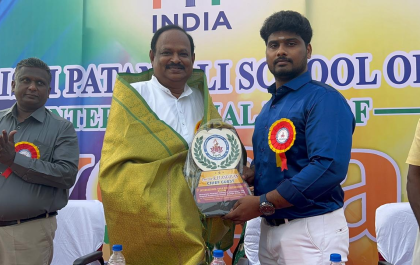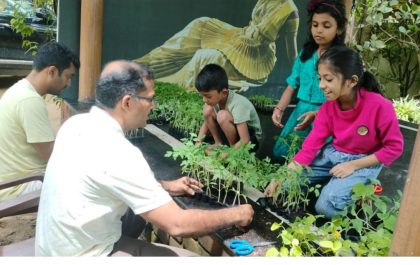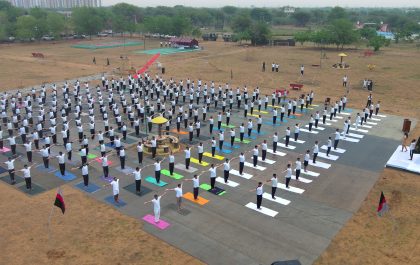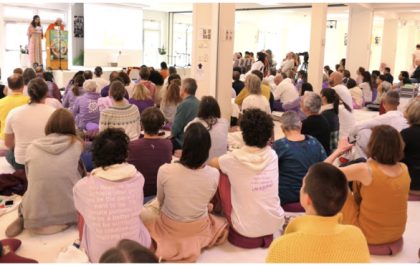A Path to Wholesomeness
According to our Guru Yogamaharishi Dr Swami Gitananda Giri Guru Maharaj, ‘Yoga Chikitsa is virtually as old as Yoga itself, indeed, the ‘return of mind that feels separated from the Universe in which it exists’ represents the first Yoga therapy. Yoga Chikitsa could be termed ‘man’s first attempt at unitive understanding of mind-emotions-physical distress and is the oldest wholistic concept and therapy in the world.’

The Nirvana Prakarana of the Laghu Yoga Vashishta, one of the ancient Yoga texts, describes in detail the origin and destruction of mental and bodily diseases. Sage Vashishta teaches Lord Rama that there are two major classifications of disease. Those that are caused by the mind are primary (Adhija Vyadhi, the psychosomatic stress disorders) while those that afflict the body directly are secondary (Anadhija Vyadhi, infectious disease, accidents etc). The primary disease has two subdivisions. These are the Samanya (ordinary physical diseases) and the Sara (the essential disorder of rebirth that may only be destroyed by Atma Jnana or knowledge of the Divine Self). Samanya diseases are the ones that affect man physically and may be destroyed by the correction of the mind-body disharmony. It is in these psychosomatic disorders that the actual practical application of Yoga practices as a mode of therapy can be very useful.
In Yoga Chikitsa it is vital that we take into consideration all of the following aspects that are part of an integrated approach to the problem. These include a healthy life-nourishing diet, a healthy and natural environment, a wholistic lifestyle, adequate bodywork through Asanas, Mudras and Kriyas, invigorating breath work through the use of Pranayama and the production of a healthy thought process through the higher practices of Jnana and Raja Yoga.

The application of Yoga Chikitsa can be correlated with the Pancha Koshas and various Yoga practices may be used as therapeutic interventions at different levels in this respect.
Annamaya Kosha: Jattis (simple units of movements), Mudras (gestures for energy generation and conservation), Kriyas (structured movements), Asanas (steady and comfortable postures), along with the dietary modifications and control. Kaya Kriya, Tala Kriya, Dridha Kriya are good examples of the Gitananda Yoga techniques that may be used at this level. The Loma Viloma set of practices is also excellent.
Pranamaya Kosha: Shat Karmas (cleansing actions), various Pranayamas, development of breath awareness, working on breath-movement coordination and the energizing and balancing of the Pranic energy. The Hathenas of Gitananda Yoga offer us a wonderful tool to use at this level.
Manomaya Kosha: Trataka (concentrated gaze), Dharana (concentration), Dhyana (meditation), Japa and Japa-Ajapa practices are useful. Various aspects of concentration such as the Mandala Dharana and other Yoga Drishti techniques are available in Gitananda Yoga for this purpose.
Vijnanamaya Kosha: Swadhyaya (self-analysis), Satsangha (lectures and spiritually uplifting exchange) along with the wonderful Jnana Yoga and Raja Yoga relaxation and concentration practices of Gitananda Yoga.
Anandamaya Kosha: Learning to implement the principles of Karma Yoga (Yoga as skilled action performed without expectation) and following the principle of action in relaxation help us to bring about joy in all our activities. A realization that we live in a blissful universe and that all life is joy is to be brought about in this intervention through use of Bhakti Yoga, Karma Yoga and other aspects like Bhajana, Yogic counseling and Satsangha. The Mantralaya and other Laya Yoga practices of Gitananda Yoga are excellent for producing effects at this universal level as the individual energies are absorbed or reabsorbed into the Divine.
Extensive research on Yoga Chikitsa being done all over the world has shown promise with regard to various disorders and diseases that seem to be amiable to Yoga therapy.
These include the psychosomatic and stress disorders such as bronchial asthma, diabetes mellitus, hypertension, irritable bowel syndrome, gastro-intestinal ulcer diseases, atherosclerosis, seizure disorder (epilepsy) and headache.
It also includes physical disorders such as heart disease, lung disease, and mental retardation. Psychiatric disorders such as anxiety disorders, obsessive-compulsive disorder, depression and substance abuse can also be managed along with other therapies.
Musculoskeletal disorders such as lumbago, spondylosis, sciatica and carpal tunnel syndrome can be tackled effectively with Yoga practices that offer a lot of hope in metabolic disorders such as thyroid and other endocrine disorders, obesity and the modern metabolic syndrome.
I reiterate that the need of the modern age is to have an integrated approach towards therapy and to utilize Yoga therapy in coordination and collaboration with other systems of medicine such as Allopathy, Ayurveda, Siddha and Naturopathy. Physiotherapy and Chiropractic practices may be used with Yoga if needed. Advice on diet and lifestyle is very important, irrespective of the mode of therapy that is employed for a particular patient.
As the field grows worldwide, it is imperative that we maintain quality. We have to move forward and be cautious as there are many dangers. Though we know that Yoga Chikitsa is useful in bringing about a state of total health it is not a miracle cure for all problems.
We need to apply a lot of discrimination both on the part of the therapist as well as the patient. We need to admit that it may not be useful in emergency conditions and that we need to be humble and consult qualified medical doctors when in doubt. Each patient is different and so the therapy has to be moulded to suit the individual needs rather than relying on a specific therapy plan for patients suffering the same medical condition.
A very real problem is the differing approaches of the different schools of Yoga to the same condition. It is better to follow any one system that one is conversant with, rather than trying to mix systems in a ‘Yogic Cocktail’. One must also be vigilant as there is a strong presence of numerous quacks pretending to be Yoga therapists and this leads to a bad name for Yoga Chikitsa as well as Yoga in general.
When approached with humility and openness, Yoga can help us regain the ease we had lost through dis-ease (as implied by sthirasukhamasanam). It can also produce mental equanimity (samatvam yoga uchyate) where the manifest opposites cease to affect us negatively (tatodwandwaanabhigatha).
This enables us to move from a state of illness and disease to one of health and wellbeing that ultimately allows us to move from the lower animal nature to the higher human nature and finally the highest Divine Nature.
